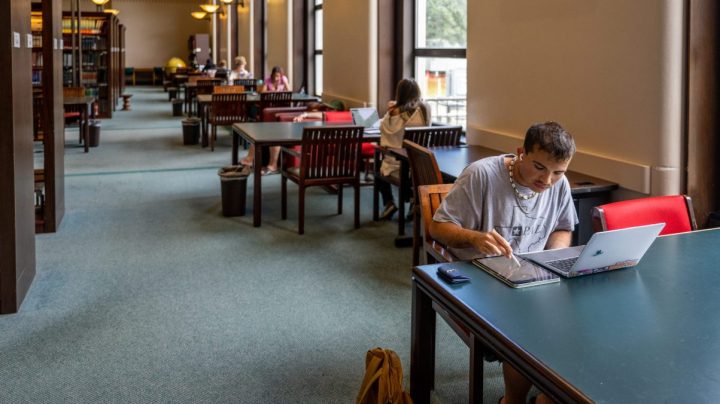
After high school years interrupted by COVID, students calculate the cost of college differently
After high school years interrupted by COVID, students calculate the cost of college differently

For this year’s high school seniors, the COVID-19 pandemic started in the spring of their ninth grade year. That means it was the meat in the sandwich of their high school education, and it’s affected their thinking about college and whether it’s worth the return on investment.
With a hot job market, more are deciding not to pursue higher education. This spring, there were 14.2 million undergraduates in the U.S., which is about 9% fewer than were enrolled in spring 2019, according to research out this week from the National Student Clearinghouse Research Center.
For some individual schools, that change is tangible. At Niagara Falls High School in western New York, the senior class is usually between 400 to 500 kids. In 2019, nearly three-quarters of them planned to go to college. Last year, that dropped to around half.
“They want to be on their own. They want to pay their own bills,” said Marc Daul, who counsels students as a postsecondary success coordinator at the school.
Part of Daul’s work is to introduce students to career options that don’t require college. He takes them to see local employers, from horse farms to gas suppliers to ones connected to the area’s famous natural wonder, which many of them have never really visited.
“We’ve taken kids out on the Maid of the Mist down at Niagara Falls,” said Daul. “We talk about jobs in the tourist industry.”
The idea is to give them information about the wider world.
“I think a lot of times kids go to college just to go to college. And they’re just not sure,” said Daul. “And they don’t finish their first year.”
There’s research from Georgetown that looks at pathways to good jobs, with salaries starting around $38,000. The data shows students without a college education do land those jobs, but they’re more likely to get one if they have a bachelor’s degree.
At some schools, almost all students want to pursue higher education. That’s true at Stuyvesant, a famously competitive public high school in New York City. At the end of a recent school day, Jeff Makris, the Director of College Counseling there, had just finished a student meeting in his office, where he’s surrounded by pennants and mascots.
“I have a lot of swag from colleges,” said Makris. “Posters, flags, some other little trinkets. Rice has that little foldable owl, which you can see back here.”
Makris said 97% of Stuyvesant graduates go on to higher education, and conversations about the price of going are now much more common than when he started counseling back in the late ’90s.
“People didn’t realize how costly student debt could be, and it’s not just magically going to fix itself 20 years down the road,” said Makris.
Stuyvesant doesn’t track how many of its alumni complete college, though Makris said all indicators point to the vast majority graduating.
Across the country, though, about a third of the students who start college don’t graduate within six years. Some end up with debt and no degree. And many students who had their high school experience interrupted by the pandemic are calculating things differently.
That’s true for 19-year-old Aiden Coldsmith, who finished high school in Baltimore in 2021, then enrolled in a business program at a public university in the area.
“I was trying to go to my classes, but sometimes they would cancel and be like, ‘Oh, we’re gonna do it over Zoom.’ And then I just hated Zoom so much from high school, and I wouldn’t even go,” he said.
Coldsmith was also worried about the loans he and his parents were taking out. His first semester of tuition (and living on campus) cost about $10,000, and paying for classes he didn’t even like didn’t seem like a good investment.
So he left, worked with AmeriCorps, and now has a job with a nonprofit, planting trees around Baltimore. He makes $15.50 an hour and lives at home to reduce his expenses. He loves the work, even though it doesn’t come with a plan.
“I feel like there’s more, but I don’t know where right now,” Coldsmith said.
He added that if people know why they’re going to college, it makes sense to go. Otherwise, it’s good to try something else first.
A kind of break — for a group of people that had their high school experience broken too.
There’s a lot happening in the world. Through it all, Marketplace is here for you.
You rely on Marketplace to break down the world’s events and tell you how it affects you in a fact-based, approachable way. We rely on your financial support to keep making that possible.
Your donation today powers the independent journalism that you rely on. For just $5/month, you can help sustain Marketplace so we can keep reporting on the things that matter to you.












